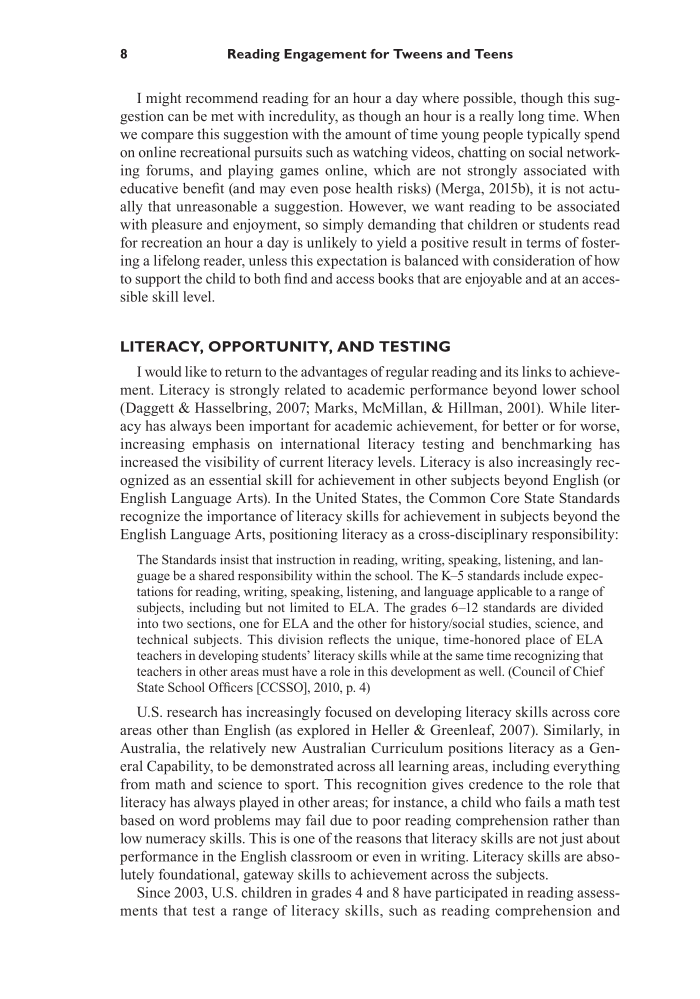8 Reading Engagement for Tweens and Teens I might recommend reading for an hour a day where possible, though this sug- gestion can be met with incredulity, as though an hour is a really long time. When we compare this suggestion with the amount of time young people typically spend on online recreational pursuits such as watching videos, chatting on social network- ing forums, and playing games online, which are not strongly associated with educative benefit (and may even pose health risks) (Merga, 2015b), it is not actu- ally that unreasonable a suggestion. However, we want reading to be associated with pleasure and enjoyment, so simply demanding that children or students read for recreation an hour a day is unlikely to yield a positive result in terms of foster- ing a lifelong reader, unless this expectation is balanced with consideration of how to support the child to both find and access books that are enjoyable and at an acces- sible skill level. LITERACY, OPPORTUNITY, AND TESTING I would like to return to the advantages of regular reading and its links to achieve- ment. Literacy is strongly related to academic performance beyond lower school (Daggett & Hasselbring, 2007 Marks, McMillan, & Hillman, 2001). While liter- acy has always been important for academic achievement, for better or for worse, increasing emphasis on international literacy testing and benchmarking has increased the visibility of current literacy levels. Literacy is also increasingly rec- ognized as an essential skill for achievement in other subjects beyond En glish (or En glish Language Arts). In the United States, the Common Core State Standards recognize the importance of literacy skills for achievement in subjects beyond the En glish Language Arts, positioning literacy as a cross- disciplinary responsibility: The Standards insist that instruction in reading, writing, speaking, listening, and lan- guage be a shared responsibility within the school. The K–5 standards include expec- tations for reading, writing, speaking, listening, and language applicable to a range of subjects, including but not limited to ELA. The grades 6–12 standards are divided into two sections, one for ELA and the other for history/social studies, science, and technical subjects. This division reflects the unique, time- honored place of ELA teachers in developing students’ literacy skills while at the same time recognizing that teachers in other areas must have a role in this development as well. (Council of Chief State School Officers [CCSSO], 2010, p. 4) U.S. research has increasingly focused on developing literacy skills across core areas other than En glish (as explored in Heller & Greenleaf, 2007). Similarly, in Australia, the relatively new Australian Curriculum positions literacy as a Gen- eral Capability, to be demonstrated across all learning areas, including everything from math and science to sport. This recognition gives credence to the role that literacy has always played in other areas for instance, a child who fails a math test based on word problems may fail due to poor reading comprehension rather than low numeracy skills. This is one of the reasons that literacy skills are not just about performance in the English classroom or even in writing. Literacy skills are abso- lutely foundational, gateway skills to achievement across the subjects. Since 2003, U.S. children in grades 4 and 8 have participated in reading assess- ments that test a range of literacy skills, such as reading comprehension and
Document Details My Account Print multiple pages
Print
You have printed 0 times in the last 24 hours.
Your print count will reset on at .
You may print 0 more time(s) before then.
You may print a maximum of 0 pages at a time.

































































































































































































